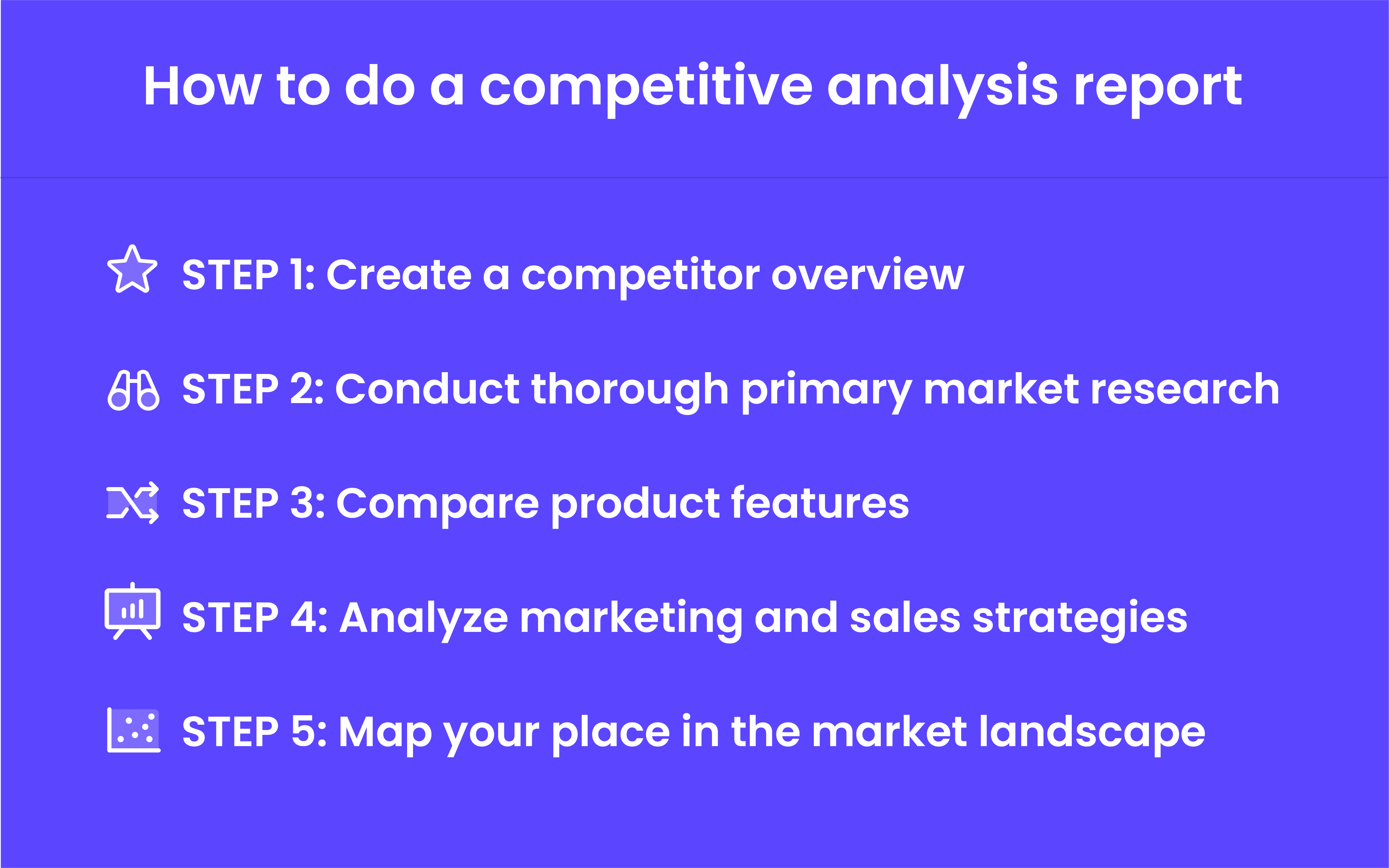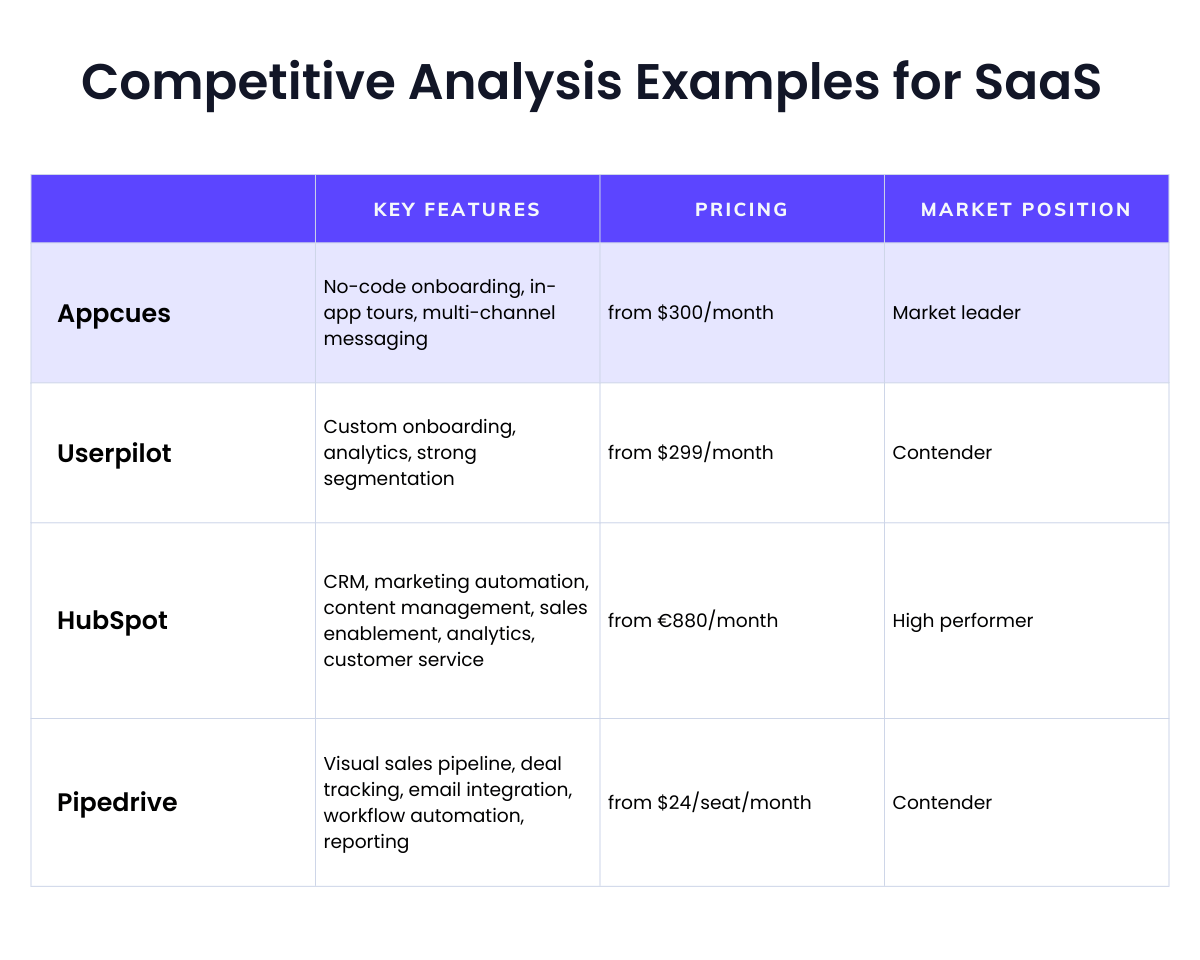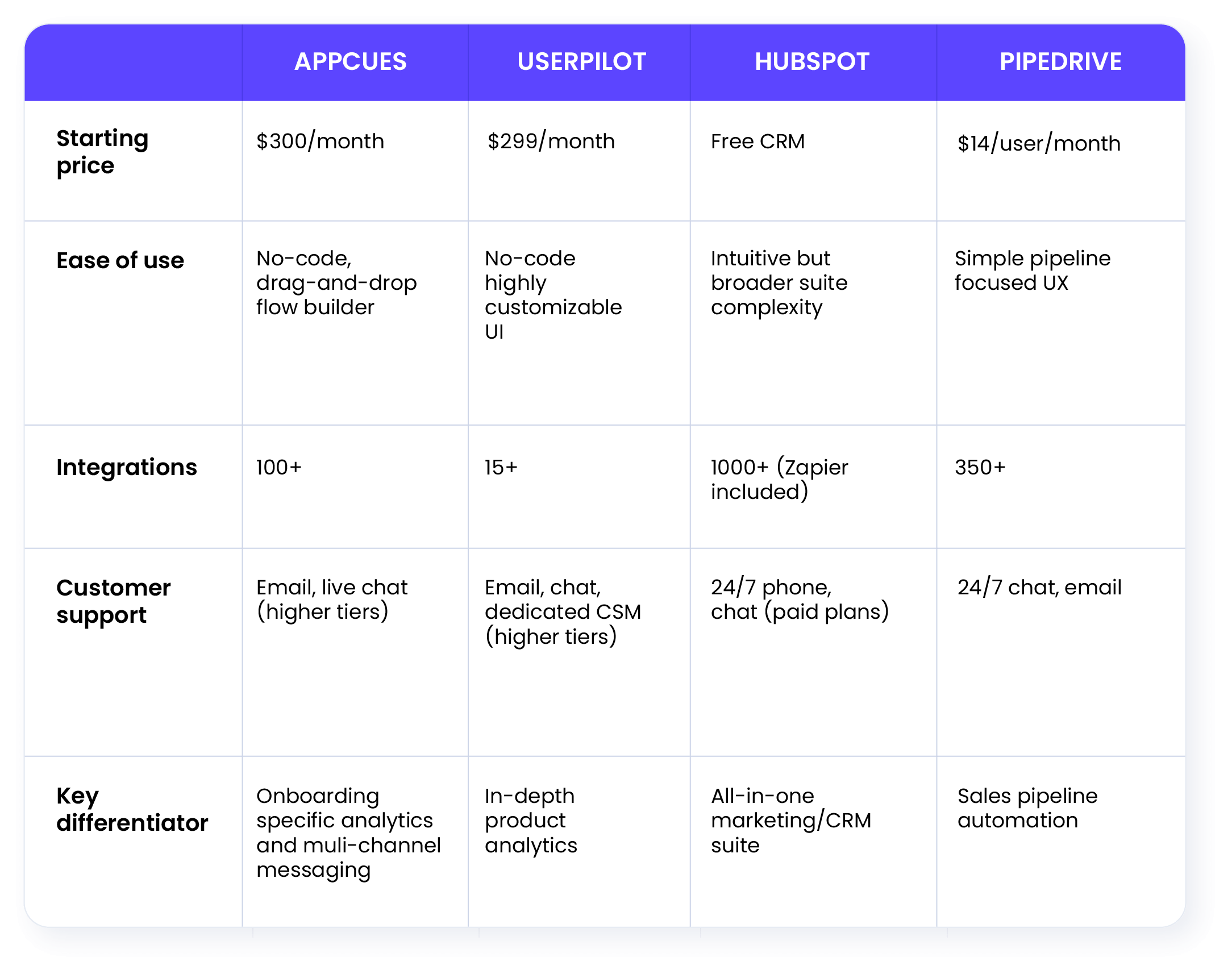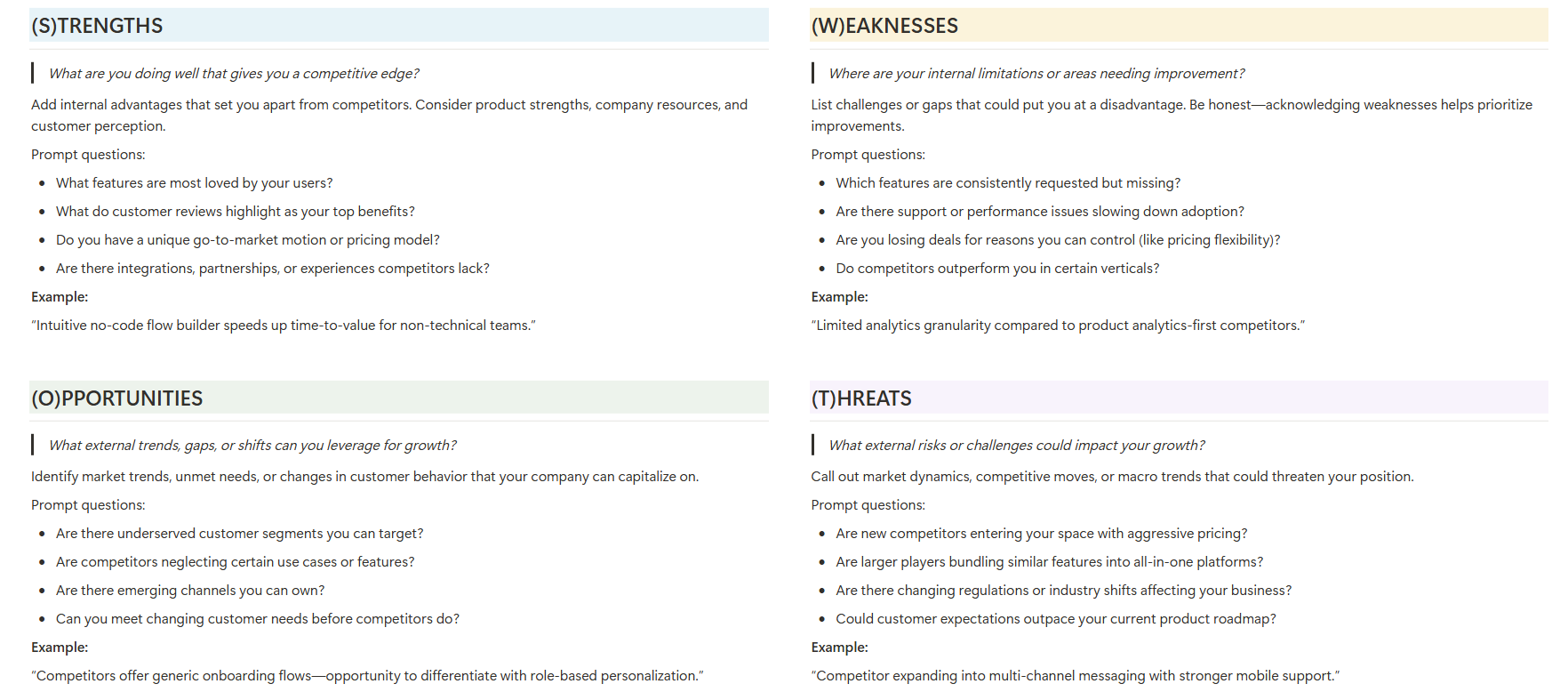How to Do a Competitive Analysis: SaaS Framework + Real Examples

.png)

.png)
Competitive analysis isn't just about knowing your rivals, it’s your edge in a crowded SaaS market. Learn how to uncover market gaps, shape product strategy, and outmaneuver competitors with our step-by-step framework and free templates.
Nearly one-third of startups won’t make it past year three.
And more often than not, the cause isn’t funding or timing. It’s the brutal truth that their product never fit the market.
The best way to avoid that fate? Competitive analysis.
It’s not just about knowing what your rivals are up to. It’s how you figure out what your product needs to do differently, and why. Who they’re targeting, how they’re positioning, where they’re dropping the ball… it’s all signal.
Signals that help you build smarter, message sharper, and win faster.
Because product-market fit isn’t found in a vacuum. It’s forged in contrast.
By building out your competitive analysis, you're digging one level down to understand not only who you're up against, but also your own company's identity.
Never forget that although you might be one of thousands fighting for attention, knowing the playing field is just another way to get the inside scoop on industry trends.
So how do you start forming an opinion? And what are the most common areas What your main competitors are doing right to keep their customers happy to research when you're planning your competitor analysis report?
That's why you're on this blog, right? To learn the secret art of analyzing the competitive landscape. We'll walk you through:

For SaaS companies, competitive analysis looks at the current market's products, pricing, and their go-to-market (GTM) strategy.
And before you ask: no, this has nothing to do with corporate espionage.
This methodology has everything to do with understanding strengths, weaknesses, and market positioning.
When you look at your business strategy as one among many, you can better understand:
By specifically comparing yourself to other business' features, messaging, and even their social media strategies, you can identify opportunities and gaps to gain a competitive advantage.
But if you want to actually identify gaps and not just lean on wishful thinking, you'll need to understand the backbone of a good competitive analysis report.
There are the six main parts in a competitive analysis report: the executive summary, company overview, product/service analysis, marketing and sales strategy, SWOT, and further recommendations.
Let's break down each and show you what they look like.
Not everyone will be as excited about your 5 pages of journalistic study. The executive summary is your quick statement for those too busy or distracted to read your full report. Your bird’s-eye view of the most important insights, findings, and main takeaways.
To start you off, here's an example about this very blog:
And to take with you, use this fill-in-the-blanks summary:
Now it's time to give a broad description of the other companies you're up against. That's your competitor's structure, size, funding, target market, and positioning. That way, your analysis has immediate context for what you're talking about and why.
Let's do another quick example of what this looks like in practice. We'll use our own company, Appcues:
And of course, here's the fill-in-the-blanks version for your work:
Not everyone is going to want to search through page after page of specs or feature lists. This section helps you get to the core of the matter: how your product compares to what your competitors are offering, in terms of features, pricing, and the user experience.
Here's what this looks like in practice:
Use this template to adapt it to your own product:
This part analyzes how your company gets attention and converts visitors into leads. It covers messaging, channels, and go-to-market tactics, exposing what’s working, what isn’t, or where you might stand out.
Let's run this through an example:
Do it yourself now:
A succinct, swift summary of the strengths, weaknesses, opportunities, and threats of each competitor. This snapshot allows you to take the temperature of where everyone is and where you might be able to make some progress.
What does this look like in practice?

Start in four simple steps:
Strengths: [Where the company excels]
Weaknesses: [Where it falls short]
Opportunities: [Gaps or trends in the market to take advantage of]
Challenges: [Competitors, market or regulation]
Turn insights into action with recommendations. At this point, you'll want to give your team the exact next steps they need to take advantage of opportunities and respond to threats, not just generic advice.
We've prepared a couple of ideas for you to get started, but remember to stay creative:
And a template for a faster start and a bit more order to your thoughts:
Those competitor analysis report elements make it a flexible tool, whether you’re repurposing it for a stakeholder presentation or sharing with your team to hone strategy.
The best competitive analysis is rinse and repeat; you can use it quarterly to stay aligned, or during product launches to get a firmer handle on positioning. The marketplace changes at the drop of a hat, but knowing how to stay ahead without burning out is vital.
A competitive analysis framework is meant to keep the practice alive, well, and repeatable whenever you need it, so you don't start from scratch every single time.
There are 6 main steps your team should rely on in a competitive analysis framework.
Choose three to five direct and indirect competitors based on:
Tip: Include both big players (market leaders) and emerging disruptors.
Gather insights from both primary and secondary sources:
Goal: See how they present themselves and how the market responds.
Build a feature comparison table with categories like:
Bonus: Identify differentiators (where you’re stronger/weaker) and feature gaps to exploit.
Do a SWOT analysis and try to define your positioning vs the competition and what actionable insights you can learn from that:
Tip: Focus on what your opportunities and threats are by outlining a new plan/strategy that will allow you to better understand the market you need to fill, way before your competitors do.
Convert your SWOT results into clear, action-oriented recommendations for each team:
Focus point: The more specific and actionable the advice, the better. Example: “Focus on CRM integrations in Q3 for a key weakness flip and win enterprise accounts.”
Summarize your findings and recommendations in a quarterly report to keep your organization informed and ahead of the game:
Pro move: Have a quarterly meeting to review this report, gather feedback, and re-prioritize if necessary. This keeps teams agile, so you’re always ready to respond to change.

Let's move on to the "how": Just five steps any team can use to identify competitors, run a thorough analysis, and advance their own business.
Start by asking yourself why you need the competitor analysis. Is it to touch up your product roadmap, tweak your prices, or fine-tune marketing? Pick five to ten competitors when you're starting out, but it's best to regularly add more competitors to your competitive market research.
What to capture:
Tip: Use search engines and industry directories to discover competitors and make sure to always update your overview as new market entrants appear.
Pull competitor data from their website, pricing page, and blogs where you can get a better understanding of their positioning and offerings.
Here's what to do every step of the way:
Where to go next: Pull everything into a spreadsheet for easy comparison and referencing. Using this approach, you’ll understand exactly how competitors position themselves and also how their customers experience the product.
Create a comparison table with the competitors' features so you can reuse the information internally whenever needed. Then:
Important: Maintain a comparison table for internal reference, so the teams can easily update and reuse the insights whenever required.
Knowing the way your competitors are drawing, engaging and converting customers is a must-know to hone your own marketing and sales tactics. Here's where to start:
Tip: Use these insights to tighten up your own buyer personas, sharpen your value-building proposition, and highlight your differentiators. This ensures your approach to marketing and sales stays aligned with what's working in the real world and the expectations customers now have.
Your competitive analysis wrap-up is to visually place your product in the SaaS market. You can make this easier by mapping yourself and significant competitors on a quadrant chart and get an idea of how you compare in terms of customer satisfaction and market share.
A couple of steps here:
Step 1. Use 2x2 quadrant matrix: Plot customer satisfaction (from G2 ratings, NPS scores) on the X axis and market share (from web traffic, companies’ funding data) on the Y axis.
Step 2. Add your products and the top 5-10 competitors: Make sure to include both direct and indirect competitors to get an overall perspective.
Step 3. Interpret the quadrants: Use this template to understand where you and each competitor stand:
Leaders: High satisfaction, high share of market
High performers: High satisfaction, low market presence
Contenders: Low satisfaction, high market
Niche players: Low satisfaction, low market presence
Step 4. Spot opportunities: Find market niches where competition is weak or doesn’t exist (such as small businesses or niche verticals).
Tip: Keeping an up-to-date map for your market and refining it as new information comes to light will mean that your strategy always accurately represents the current state of the market.
Let's see what it looks like when everything comes together. What does this actually look like in real life? We're taking our very own Appcues product for this competitive analysis example.
At step 1, we'll decide on the primary goal of our competitive analysis report. In this case, the scope is identifying fundamental differentiation opportunities for Appcues when it comes to key features and pricing:

At step 2, we'd be pulling in all the data we can find from company websites, G2 reviews, pricing pages, social media, and an SEO tool like Ahrefs for website traffic estimates.
Here's a quick example but remember you can get as detailed as you'd like with this:
Appcues: Website primarily highlights multi-channel, no-code personalization options. G2 reviewers rave about ease of use and onboarding templates, but cite higher pricing along with analytics limitations.
Userpilot: Website, reviews emphasize advanced analytics and customization. Customers love the flexibility, but say there’s a steeper learning curve, and prices are higher for advanced plans.
HubSpot: Excellent features and scaling. Free tier and integrations are appreciated by users, who say advanced features can get pricey for smaller organizations.
Pipedrive: People enjoy most the Pipedrive’s easy-to-use interface and visual pipeline. Reviews say marketing automation is feature-limited and some advanced features are available only in higher plans.
For step 3, we're comparing the products' core differentiators. Here's what an Appcues vs competitors breakdown would look like in a simplified competitor analysis table format:

At step 4, it's time to dig into their marketing strategies. We'd first review our direct competitors by comparing their messaging and used promotion channels (like social media advertising or content marketing strategies):
Appcues: Specializes in onboarding quickly and without code, and in multi-channel engagement. Uses content marketing, webinars and in-app feedback. Messaging aimed at product teams looking for autonomy and quick time-to-value.
Userpilot: Focused more on analysis, customization and taking action. Also uses educational content and is primarily targeting product managers and customer success teams.
HubSpot: Markets itself as an all-in-one growth platform and is heavily focused on the inbound marketing angle. Strong investment in content, SEO and partner network.
Pipedrive: Sales-first messaging that features a clean and stripped down design with good pipeline visibility. Is dependent on social media, your content, and customer success stories
Finally, at step 5, you'll map your place in the market landscape using the quadrant approach:
Start your competitive analysis with three free templates and tips on how to customize them with your own user data and insights from Appcues:
Grab our free SWOT matrix template to better evaluate your strengths, weaknesses, opportunities, and threats.

Pull in satisfaction ratings from review websites or your NPS survey, projected market share from SEO tools like Ahrefs or Similarweb, or funding reports from Crunchbase. Use both the SWOT analysis and the market research map to identify your strengths and weaknesses and draw your competitor analysis quadrants.
Here's our market map template to help you visualize this:

Turn to internal product audits and user tests to compare features with your competition's public pricing page and feature list.
Grab this free feature comparison table to get started:

Tip: You can simplify reporting for internal or executive presentations by creating a create a one-page summary with a mini SWOT analysis, a simplified market map with only three key indirect or direct competitors, and a feature comparison matrix highlighting your top three differentiators.
A competitive analysis that’s strong goes beyond showing you where your company stands. Its main purpose? Telling you how to outmaneuver your competitors and make smarter, quicker decisions.
Key points to keep in mind to achieve this with a correct competitive analysis: